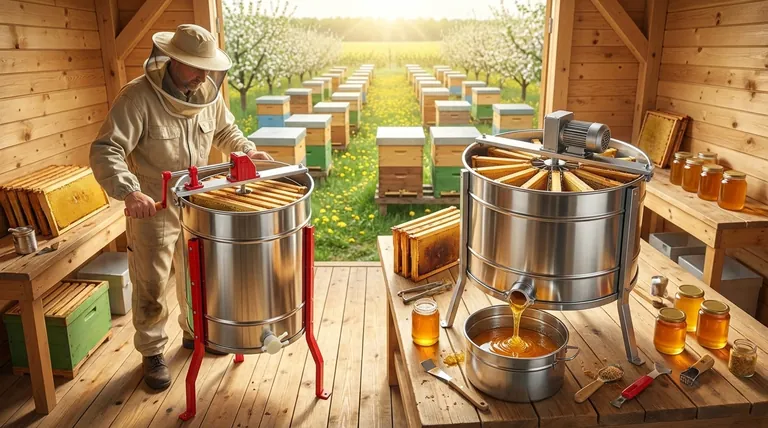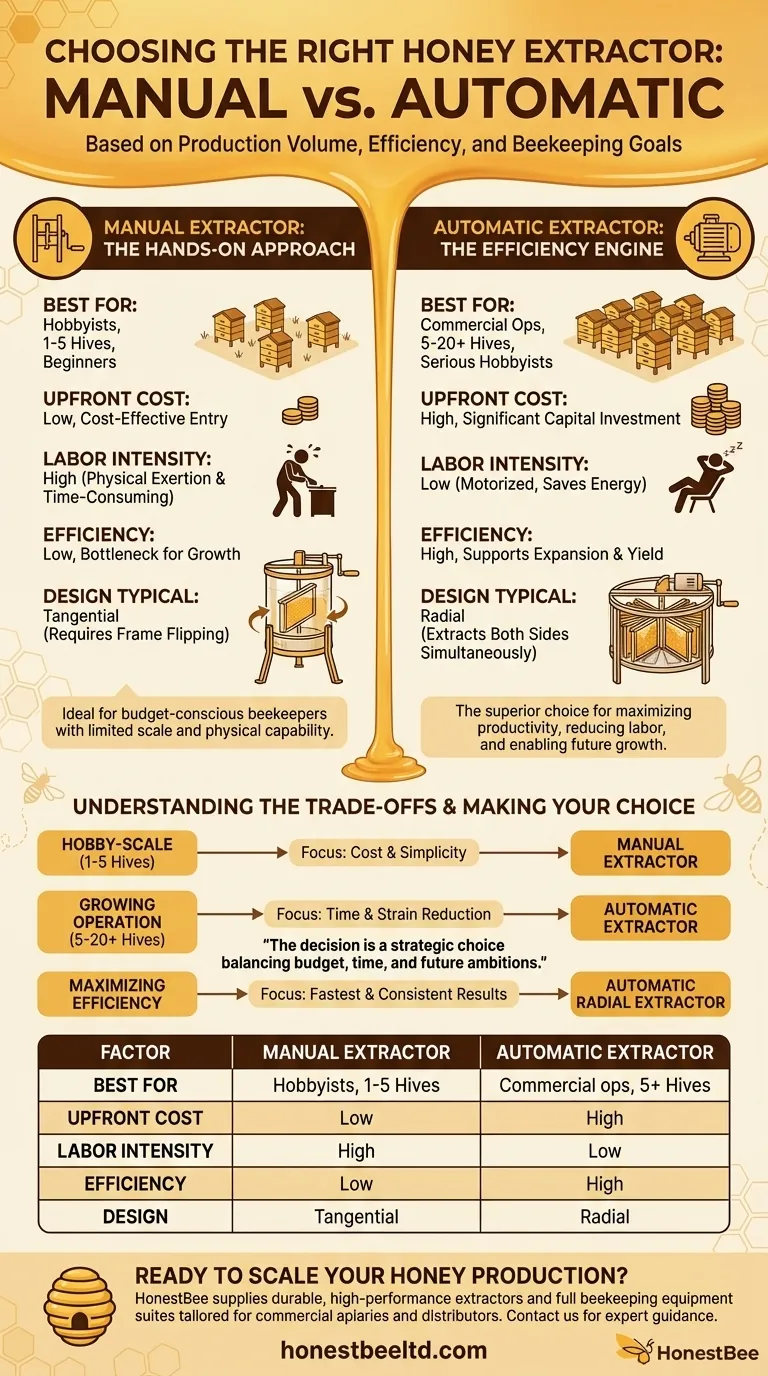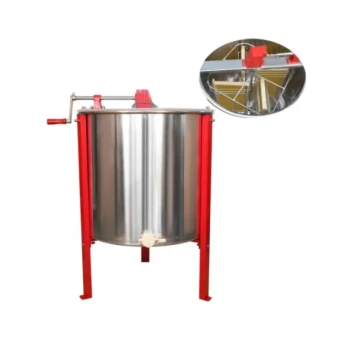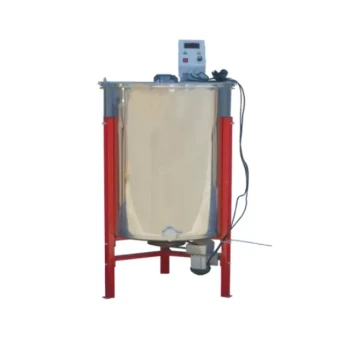Choosing the right honey extractor is a critical decision that directly impacts your efficiency and workload. For small-scale operations with only a few hives, a manual extractor is a cost-effective and viable solution. However, once production volume increases and time becomes a primary concern, an automatic (electric) model becomes essential for streamlining the process and reducing physical labor.
The decision between a manual and automatic honey extractor is not just about your current number of hives, but a strategic choice balancing your budget, your time, and your future ambitions as a beekeeper. It's an investment in either lower upfront cost or long-term operational efficiency.

The Fundamental Difference: Labor vs. Automation
The core distinction lies in the power source and the corresponding impact on your time and effort during one of the most labor-intensive periods of beekeeping.
Manual Extractors: The Hands-On Approach
A manual extractor is powered by a hand crank. It is the simplest and most cost-effective entry point into honey extraction.
These models are ideal for hobbyists or beginners who don't mind the physical effort required. They do not need a power source, making them versatile for use in any location.
The primary drawbacks are the significant time commitment and physical exertion needed to get the job done, especially with more than a few hives.
Automatic Extractors: The Efficiency Engine
An automatic extractor, also known as a motorized or electric extractor, uses a motor to spin the frames. This automates the most strenuous part of the process.
These are best suited for commercial beekeepers or serious hobbyists with large-scale production needs. They offer faster, more consistent results, which can maximize your honey yield.
While the upfront cost is higher and a power source is required, the investment pays off by dramatically reducing labor and boosting productivity.
Beyond Power: How Extractor Design Impacts Your Choice
The method of operation—manual versus automatic—is often linked to the internal design of the extractor, which has its own efficiency implications.
Tangential Extractors
In a tangential extractor, frames are positioned so that only one side of the honeycomb faces the outer wall of the drum.
This design requires you to stop the process, flip each frame by hand, and then spin again to extract honey from the other side. Many smaller, manual extractors use this design.
Radial Extractors
A radial extractor positions frames vertically, like the spokes of a wheel. Centrifugal force extracts honey from both sides of the comb simultaneously.
This is a far more efficient design that eliminates the need to flip frames, saving considerable time and handling. Radial designs are standard in most modern automatic extractors.
Understanding the Trade-offs
Making an informed decision requires looking beyond the initial price tag and considering the long-term operational costs and benefits.
The Cost Equation: Upfront vs. Long-Term
A manual extractor has a very low upfront cost, making it attractive for those on a tight budget. However, its "cost" in terms of your personal time and labor is high.
An automatic extractor is a significant capital expense. Its long-term value comes from the hours of labor it saves and the potential for increased production and scalability.
The Physical Demand
Do not underestimate the physical effort of a manual extractor. Cranking for an extended period is a workout, and the process is much slower, prolonging the task.
Automatic extractors reduce the process to loading frames and pressing a button, preserving your energy for other apiary tasks.
Scalability and Future Growth
A manual extractor that serves you well with two hives will quickly become a bottleneck if you expand to ten. An automatic extractor allows for future growth without requiring a new equipment purchase.
Making the Right Choice for Your Operation
Base your decision on a realistic assessment of your current needs and future goals.
- If your primary focus is hobby-scale production (1-5 hives): A manual extractor is a perfectly suitable and cost-effective starting point.
- If your primary focus is growing your operation (5-20+ hives): An automatic extractor is a wise investment that will save you significant time and physical strain.
- If your primary focus is maximizing efficiency and yield: An automatic radial extractor provides the fastest and most consistent results, making it the superior choice for any serious operation.
Ultimately, choosing the right extractor is an investment in the sustainability and enjoyment of your beekeeping journey.
Summary Table:
| Factor | Manual Extractor | Automatic Extractor |
|---|---|---|
| Best For | Hobbyists, 1-5 hives | Commercial ops, 5+ hives |
| Upfront Cost | Low | High |
| Labor Intensity | High (hand-cranked) | Low (motorized) |
| Efficiency/Scalability | Low, bottleneck for growth | High, supports expansion |
| Typical Design | Tangential (requires frame flipping) | Radial (extracts both sides simultaneously) |
Ready to Scale Your Honey Production?
Choosing the right extractor is crucial for your apiary's productivity and growth. HONESTBEE supplies durable, high-performance honey extractors and full beekeeping equipment suites tailored for commercial apiaries and distributors.
We help you invest wisely—whether you're upgrading from a manual model or sourcing efficient automatic extractors for your expanding operation. Our wholesale-focused operations ensure you get reliable equipment that maximizes your yield and minimizes labor.
Contact HONESTBEE today for expert guidance and competitive pricing on extractors built for scale.
Visual Guide

Related Products
- 2 Frame Stainless Steel Manual Honey Spinner Extractor for Beekeeping
- HONESTBEE 3-Frame Manual Acrylic Honey Extractor
- Stainless Steel Manual 8 Frame Radial Honey Extractor Machine for Beehives
- HONESTBEE 4 Frame Manual Self Reversing Honey Extractor for Beekeeping
- HONESTBEE 72 Frame Industrial Electric Honey Extractor for Beekeeping
People Also Ask
- How does centrifugation work in honey extraction? The Sustainable Method for Modern Beekeepers
- How can a pressure washer be used to clean a honey extractor? A Guide to Safe and Efficient Cleaning
- What are the advantages of tangential honey extractors? Gentle, Affordable Honey Extraction for Your Apiary
- What mistakes should be avoided during honey extraction with a centrifuge? Preserve Your Comb and Honey Quality
- What are some expert tips for cleaning a honey extractor? Protect Your Harvest & Equipment



















